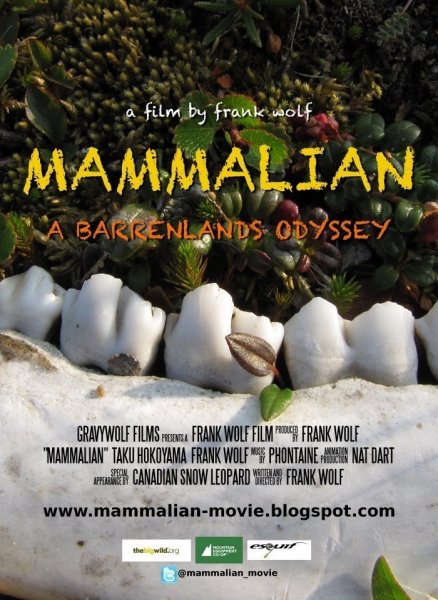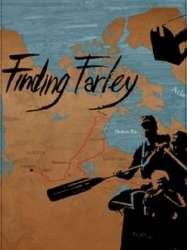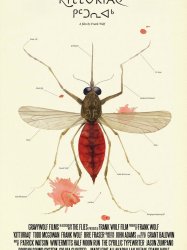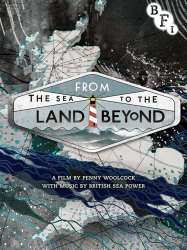Mammalian is a canadien film of genre Documentary directed by Frank Wolf
Mammalian (2010)

If you like this film, let us know!
Directed by Frank Wolf
OriginCanada
Genres Documentary
Themes Environmental films, Seafaring films, Sports films, Transport films, Documentary films about sports, Documentary films about environmental issues, Documentary films about technology, Documentary films about nature
Rating78%










Mammalian is a 2010 documentary film that follows Frank Wolf and Taku Hokoyama as they take on a 2,000 km canoe journey through the largest wilderness area in North America. Their route travels from Yellowknife, YT to Rankin Inlet, NT through a region with one of the highest concentrations of land mammals on earth. The pair encounter Arctic wolves, the caribou migration, musk ox and- most importantly- make the first ever recording of a rare and elusive creature not previously thought to exist in northern Canada. With a sense of humour and purpose, they track down politicians, First Nation chiefs, elders and others living in the few communities that frame the wilderness in order to present a clear picture of the area and the issues that face the land and its people. The film was the winner of the 'Best Environment Film' at the 2011 Kendal Mountain Festival and was one of the Top Ten Most Popular Canadian Films of the 2010 Vancouver International Film Festival. It airs on CBC's documentary (TV channel) in Canada multiple times through 2013.
Comments
Leave comment :
Suggestions of similar film to Mammalian
There are 1 films with the same director, 8965 with the same cinematographic genres, 11236 films with the same themes (including 2 films with the same 8 themes than Mammalian), to have finally 70 suggestions of similar films.If you liked Mammalian, you will probably like those similar films :

Borealis (2008)
Directed by Frank Wolf
Origin Canada
Themes Environmental films, Seafaring films, Sports films, Transport films, Documentary films about sports, Documentary films about environmental issues, Documentary films about technology, Documentary films about nature
Rating85%






Finding Farley (2009)
, 1h2Origin Canada
Genres Documentary
Themes Films about writers, Environmental films, Seafaring films, Sports films, Transport films, Documentary films about sports, Documentary films about environmental issues, Documentaire sur une personnalité, Documentary films about technology, Documentary films about nature
Rating74%






Waterwalker (1984)
, 1h27Directed by Bill Mason
Origin Canada
Genres Documentary
Themes Environmental films, Seafaring films, Sports films, Transport films, Documentary films about sports, Documentary films about environmental issues, Documentary films about technology
Actors Bill Mason
Rating80%






Kitturiaq (2013)
Genres Documentary
Themes Environmental films, Seafaring films, Sports films, Transport films, Documentary films about sports, Documentary films about environmental issues, Documentary films about technology

Directed by Penny Woolcock
Origin United-kingdom
Genres Documentary
Themes Films about animals, Environmental films, Seafaring films, Transport films, Documentary films about environmental issues, Documentary films about technology, Documentary films about nature
Rating79%






Hiroshima (1995)
, 3h10Directed by Roger Spottiswoode, Koreyoshi Kurahara, Hideo Sekigawa
Origin Canada
Genres Drama, Documentary
Themes Environmental films, Seafaring films, Transport films, Aviation films, Documentary films about environmental issues, Documentary films about war, Documentary films about historical events, Documentary films about nuclear technology, Documentary films about technology, Political films, Documentary films about World War II
Actors Eiji Okada, Kenneth Welsh, Ken Jenkins, Yumeji Tsukioka, Tatsuo Matsumura, Wesley Addy
Rating77%





The film opens in April 1945 with the death of Franklin Roosevelt and the succession of Harry Truman to the presidency. In Europe, the Germans are close to surrender, but in the Pacific the bloody battle for Okinawa is still underway and an invasion of the Japanese home islands is not foreseen until the autumn. American battle casualties have almost reached 900,000, with Japanese casualties at 1.1 million, and some 8 million Asian civilians have died in the war that began with Japan's invasion of Manchuria in 1931.

World Without Sun (1964)
, 1h30Directed by Jacques-Yves Cousteau, Albert Falco, Simone Melchior
Origin France
Genres Documentary
Themes Environmental films, Seafaring films, Transport films, Documentary films about environmental issues, Documentary films about nature
Rating74%





World Without Sun, a documentary produced and directed by Jacques Cousteau in 1964 chronicles Continental Shelf Station Two, or "Conshelf Two", the first ambitious attempt to create an environment in which men could live and work on the sea floor. In it, a half-dozen oceanauts lived 10 meters down in the Red Sea off Sudan in a star-fish shaped house for 30 days. The undersea living experiment also had two other structures, one a submarine hangar that housed a small, two man submarine referred to as the "diving saucer" for its resemblance to a science fiction flying saucer, and a smaller "deep cabin" where two oceanauts lived at a depth of 30 meters for a week. The undersea colony was supported with air, water, food, power, all essentials of life, from a large support team above. Men on the bottom performed a number of experiments intended to determine the practicality of working on the sea floor and were subjected to continual medical examinations. The documentary, 93 minutes long, received wide international theatrical distribution, and was awarded an Academy Award for Best Documentary, as well as numerous other honors. It was Cousteau's second film to win Best Documentary, the first being "The Silent World" released in 1956.

Deep Water (2006)
, 1h32Origin United-kingdom
Genres Drama, Documentary, Action, Adventure
Themes Seafaring films, Sports films, Transport films, Documentary films about sports, Documentary films about technology
Actors Jean Badin, Tilda Swinton, Simon Russell Beale
Rating77%





Un couple qui ne s'aime plus fait un accord: la femme aura le droit d'avoir des amants. Bientôt, ces amants commencent à disparaitre l'un après l'autre.

Sun Come Up (2011)
, 38minutesOrigin USA
Genres Documentary
Themes Environmental films, Seafaring films, Transport films, Documentary films about environmental issues, Documentary films about nature, Disaster films
Rating68%






No More Hiroshima (1984)
Genres Documentary
Themes Environmental films, Seafaring films, Transport films, Aviation films, Documentary films about environmental issues, Documentary films about war, Documentary films about historical events, Documentary films about nuclear technology, Documentary films about technology, Political films, Documentary films about World War II
 Connection
Connection